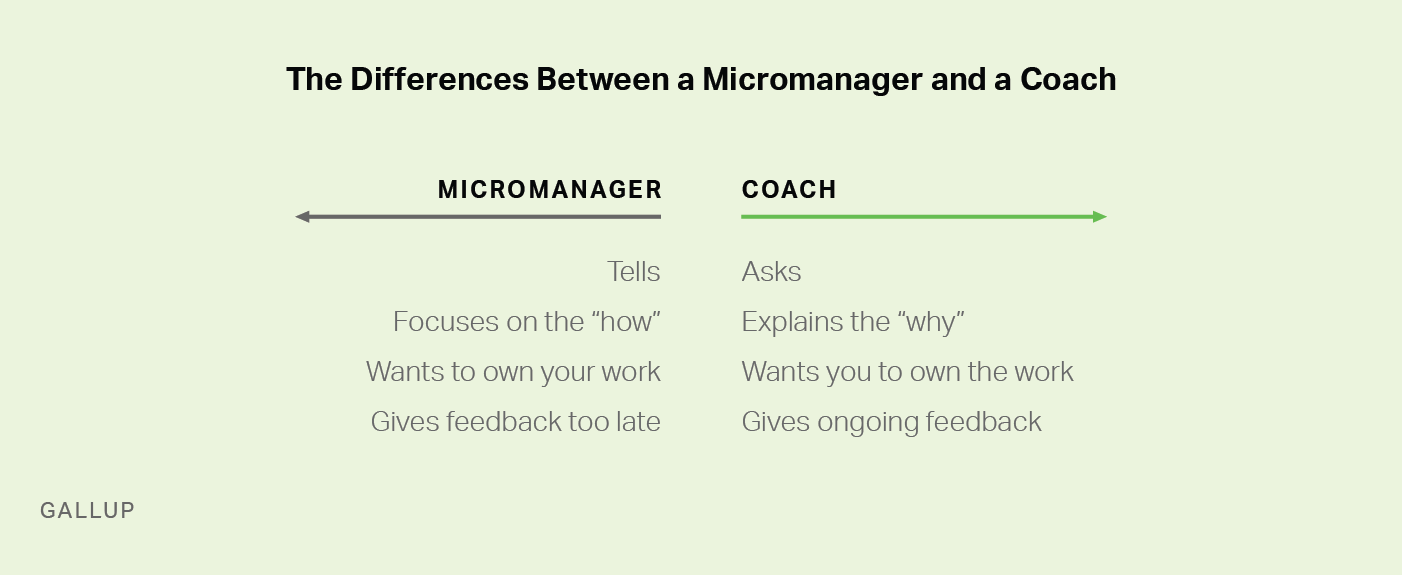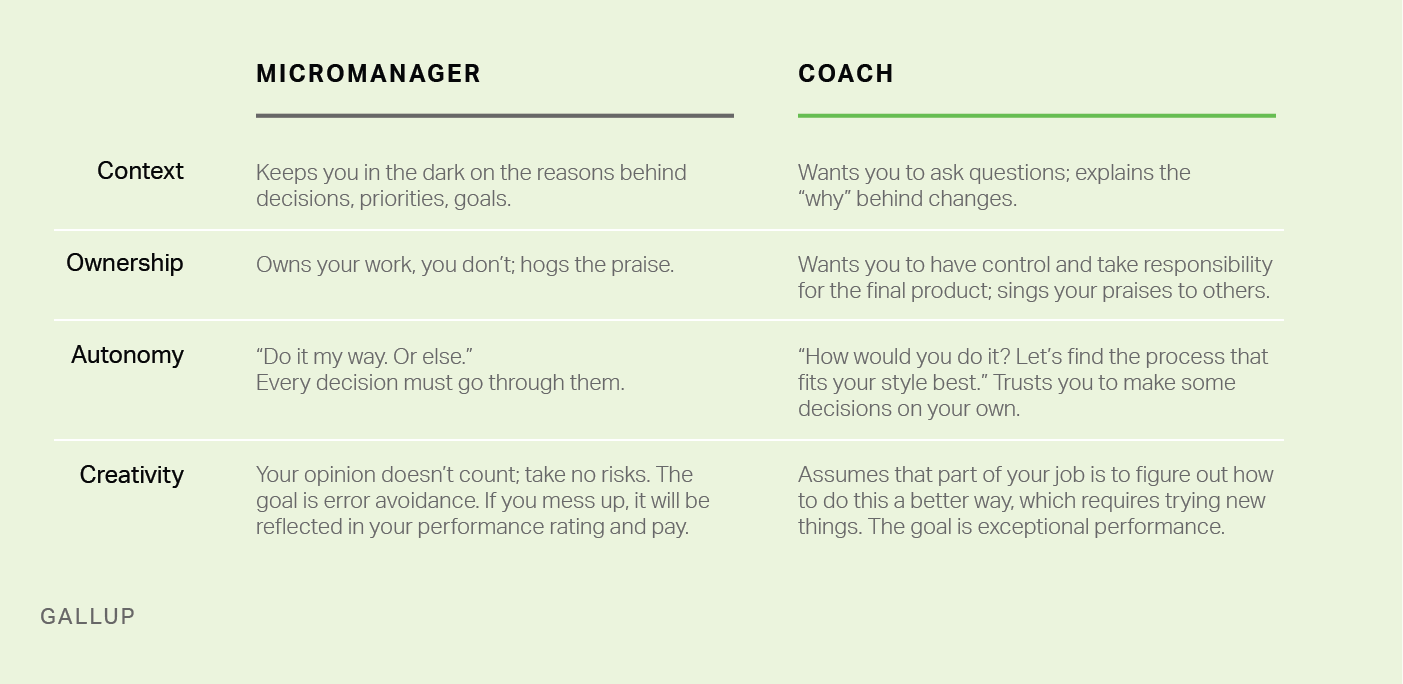Story Highlights
- You can identify a micromanager with one simple question
- Micromanaged teams can look happy but perform poorly
- Remote workers and matrixed teams still experience micromanagement
The micromanager has become a bit of a boogeyman in the business world. Nobody wants to work for one. Few managers want to be one. Everyone has a horror story about one.
Some leaders try to avoid being a micromanager at all costs -- taking a hands-off approach and letting their employees sink or swim on their own.
Other managers seem to take pride in being a micromanager. They want to be engaged, involved, deep in the weeds. They see it as a mark of a true leader.
Here's a one-question test to identify a micromanager: Is the team customer-obsessed or boss-obsessed?
A boss-obsessed team is easy to identify. The only thing that matters is what the boss thinks. Not mission, not revenue, not customers.
The most important aspects of a project -- the ones everyone is worried about -- become the idiosyncratic (but irrelevant to success) specifications of the micromanaging boss. Every decision must go through them, bottlenecking progress at each turn. Everyone is afraid to be honest. Everyone secretly knows they are delivering an inferior product or service. Nobody feels like they are doing their best work. Everyone feels constantly evaluated. Nobody wants to take responsibility.
Signs of micromanaging in teams and organizations:
- boss-obsessed rather than customer-obsessed
- acceptance of less-than-best work to pander to leadership
- every conversation with the boss feels like a performance review
- every decision must be approved by the manager
- constant project bottlenecks due to excessive meetings, gatekeeping and stakeholders
- employees are afraid to share their opinions
- a lack of new leaders coming up through the ranks
- quick turnover of talented experts
- stifled creativity, innovation and agility
Micromanaged teams can have a veneer of happiness and positivity, but the outcomes mirror those of unhappy teams: fear, paralysis and dishonesty on the inside; unhappy customers, lower-quality products and less competitive offerings on the outside. In other words, a micromanaged team (or organization) is a disaster waiting to happen.
The Big Myth About Micromanagers
One of the most common complaints about micromanagers is that they are too involved. The stereotypical micromanager wanders the cubicle farm with their clipboard, metaphorically cracking the whip to make sure everyone is hitting their numbers.
And yet according to Gallup's analysis, a majority of employees experience the opposite problem -- a severe lack of employee feedback and communication with their manager.
Forty-seven percent of employees report having received feedback from their manager "a few times a year" or less. In fact, 19% of employees receive feedback from their manager once a year or less. Thus, given the absence of advice provided by managers, it is no surprise that only 34% of employees strongly agree that their manager knows what projects or tasks they are working on.
How often do you receive feedback from your manager?
Daily: 7%
A few times a week: 19%
A few times a month: 27%
A few times a year: 28%
Once a year or less: 19%
Consider this additional fact: Even employees who say they tend to receive negative feedback wish they'd get more feedback. And even when employees receive negative feedback, focused on their weaknesses, they tend to be more engaged than when they don't receive feedback at all. It's perhaps a case of "better the devil you know than the devil you don't." The manager might be mean or misguided, but at least you know what's going on!
If micromanagement solely referred to the frequency of interactions with your boss, only 7% of workers would be worried about it. However, in a new world of work that is more complex, dynamic and team-oriented than ever before, micromanagement shows up in different ways. Remote workers and people on highly matrixed teams experience micromanagement very differently than front-line workers do -- but the negative effects are the same.
What Does Micromanaging Mean?
Today's micromanager is likely someone who wants it done exactly their way but provides little context, support, help or advice. It's easier than ever for a manager to swoop in on an email chain or conference call and make demands without having full context about what's happening.
That's actually pretty terrifying. Imagine you are an employee working on a presentation for your boss. They said they want it by the end of the week. Who's it for? How long should it be? What format do they prefer? Does the style matter? You're afraid to get anything wrong, but the manager is unavailable and unresponsive until the very last moment.
In a rush, they look over your work and start listing everything that's wrong with it. Of course, you could've avoided all of this with some communication -- but now you're hurrying to fix "your mistakes." (Or, just as likely, the presentation was canceled days ago, and you were never informed, wasting a week of your time.)
Your boss micromanages -- nitpicking mistakes based on their idiosyncratic whims and ego. But the problem wasn't over-involvement throughout the process; it was the lack of an ongoing partnership. This results in confusing expectations, wasted time, unnecessary stress and shame.
You've been victimized by the "fly-in and fly-out" micromanager.
Today's micromanager is likely someone who wants it done exactly their way but provides little context, support, help or advice.
Here's the difference between micromanaging and great coaching:
Micromanaging creates a transactional relationship in which the manager fixates on minor mistakes and focuses on a person's weaknesses and work style. Great coaching, on the other hand, is an ongoing relationship of support and trust that emerges out of a rhythm of collaborative conversations, leading to teamwork and shared accountability.

Custom Graphic. The differences between a micromanager and a coach are tells versus asks and focuses on the how versus explains the why.
Be a Coach, Not a Micromanager
Why does being micromanaged suck?
Dealing with a micromanager strips you of context, ownership, job autonomy and creativity. A micromanager says, "Do it my way." They tell you how to accomplish something exactly step by step (often after the fact) and require perfect conformity to their process. They don't give you context into how and why things are done this way, and they don't want to hear about improving or innovating to achieve better outcomes. Moreover, when you don't follow their rules, they see it as a sign of disrespect. The focus is on failure, mistakes and weaknesses, rather than spotting potential and seeking continuous improvement.
Micromanaging can be particularly infuriating when the manager (or a different stakeholder) does not share the expertise of the team they lead. Employees feel like they've been hired to provide their expert opinion, only to find that their opinion doesn't count when a manager or leader has a "gut feeling" about how things should be otherwise.

Custom Graphic. The differences between a micromanager and a coach regarding context, ownership, autonomy and creativity.
A great coach respects the opinions of their team members. They empower those team members to ask questions, take responsibility for their work, do it in a way that makes sense to them, and come up with more efficient and effective ways of achieving the same goal. Most importantly, they have frequent, two-way conversations with their team members that lead to shared accountability for their performance expectations.
Ultimately, all the limitations of the micromanager affect employee development. If you never learn how your organization works, never get credit for your work and never get to contribute meaningfully to the success of projects, you will obviously struggle to find purpose and advance in your career.
In contrast, a coach works as your ally and advocate. They explain how to get things done, remove roadblocks, sing your praises to influential people when you excel, and expect you to master your job and advance over time.
Consider the previous complaint about the "too involved" micromanager. The truth is that when a manager has a trusting, two-way relationship with an employee, it's nearly impossible to be too involved. You're not bossing. You're working together. And that makes all the difference.
What are the root causes of micromanagement?
Micromanaging occurs when there is no relationship of trust and support between a manager and an employee. Managers don't trust employees because, frankly, they don't know them. And vice versa. You can't flip a switch and turn on trust -- it must be nurtured over time through conversations and actions. Managers must show they care, and they have to prove to their team that they have the team's back.
Gallup analysis has shown that most managers do not have natural giftedness in managing people. That could be a primary cause of the AWOL manager. They simply haven't been trained in best people management practices. They are trying to "play manager" by withholding information, making snap decisions, pointing out errors and clumsily taking control during stressful times -- only to create more problems than they solved.
Alternatively, a well-meaning manager can take "manage to outcomes" too far. They make employees feel like they're being constantly evaluated but with little support to achieve success. Conventional management advice says, "Don't tell people how to do it. Point them at the goal and let them figure it out." The point is well-taken. Autonomy matters. But managers also need to provide support and celebrate progress. If managers spend all their time pointing at the scoreboard, they are hardly leading at all.
When should managers be more direct?
Sometimes employees need more direction, and drowning them in ambiguity only makes things worse. This is particularly common when employees are learning something new, experiencing extreme confusion or facing serious consequences for making a mistake.
Defining outcomes appropriately is critical for these different types of performance expectations. When they are learning something new or performing a complex task, it's OK for goals to be a bit more vague or progressive. But when role clarity or immediate changes are needed, goals and outcomes should be very specific.
Managers should be more direct when:
- onboarding employees to a new role
- new responsibilities are assigned
- the task is more complex and ambiguous than usual
- performance improvement is severely needed (e.g., performance improvement plan)
- meetings end with lots of follow-up items and logistics to be coordinated
- an individual specifically requests or generally prefers more feedback
How Senior Leaders Create a Culture of Micromanagement
Another reason that micromanaging takes hold in an organization is that sometimes executive leaders are micromanagers themselves. They bring their ego to every meeting, and every decision is personal. They put their egos ahead of the mission or customers or even profits. They said it, so it's the law, and they are not open to any other opinions.
Signs of a leader who micromanages:
- They withhold context and keep their subordinates in the dark.
- They take control in an inconsistent way that leaves followers wondering if they should act before receiving their orders.
- They don't give public praise and recognition to their team.
- They spend too much time on decisions that others could handle.
- They don't listen to the opinions of their team.
- They focus on criticizing what people do wrong rather than on developing their strengths.
Leaders can also turn their managers into micromanagers when they put extreme pressure on certain narrowly focused goals, metrics and outcomes, to the detriment of overall organizational needs and health. Anxious organizations increase performance expectations but do not provide additional support or communication to match it. This leaves managers confused and afraid, and they cascade that fear down to the front lines.
How to Fix Micromanaging in Your Organization
The micromanager style festers in workplace environments where people don't know what success looks like, don't know each other, don't communicate, don't ask questions and don't expect change.
Organizations can eliminate micromanaging by creating a work culture where everyone owns the success of the organization. When leaders build a culture of trust in the workplace and implement constructive candor that assumes change and growth (in processes and individuals), the toxic inefficiencies of the micromanager become obvious to all.
Here are a few ways to address micromanaging in your organization and create cultural transformation:
1. Create a company culture of trust and shared accountability.
How do we build relationships? How do we work together? When shared ownership and great teamwork exist, micromanagement only slows things down and deteriorates outcomes. Define "how we get work done" for your organization, and live it. When leaders, managers and teams are expected to take ownership of the work and build trust, people behave differently. They want to do work that matters and be good teammates. Free them.
2. Focus on strengths.
Who should do what? Performance potential starts with assigning the right person to the right task and right team. Sir Richard Branson's famous tips for delegating work start with: 1) Know your strengths and weaknesses, and 2) Know your teams' strengths and weaknesses. When people are assigned to the right work and partners, magic happens. And micromanagers only get in the way.
3. Shift from old-school performance management to modernized "ongoing conversations."
What should expectations and success look like? How do we get there? Old-school performance management focused on annual goal setting and reviews, evaluation and pay. None of those things work when they're only discussed once a year. Set clear goals in collaboration with employees, and adjust them as work and priorities change. Be a great coach: Communicate, communicate, communicate. And teach your team to communicate. Make employees share accountability for the goals they help set, for team building and performance, and for customer impact.
4. Prioritize development.
How do we get better? Organizations only improve when their people improve. Continual improvement requires an employee development plan. Agility and innovation require development. Employees require development -- if you want to engage them and build a bright future for them at your company. That means employees want new responsibilities and to be stretched. Professional development happens through opportunity and delegation of the right work -- not through micromanagement.
5. Be mindful of what you recognize and reward.
What do we celebrate? Leaders may hate the stagnant micromanager culture they've created and yet continue to feed that culture formally and informally through their individual praise, corporate communications, internal awards and performance management systems. If organizations want to de-emphasize micromanager tendencies, they need to shift their awards, rewards and recognition toward team collaboration, cross-team partnerships and outstanding individual contributions.
You can't flip a switch and turn on trust -- it must be nurtured over time through conversations and actions.
Organizations start to die when they begin to focus more on pleasing themselves than pleasing their customers. When leaders and managers create a "boss-obsessed" culture, it may feel like the organization is strong -- but it's actually calcifying from the inside out.
Healthy, vibrant organizations are constantly improving and innovating in response to the market. They do not expect to be doing business the same way next year. They recognize that in order to survive, they need ever-improving individuals and teams who take ownership of their work and future. That requires great coaches, not micromanagers.
If you find yourself in one of these four categories, there are some action items you can implement immediately:
"Help! I am being micromanaged."
- Initiate relationship-building conversations to improve mutual trust.
- Ask if you can give some input into the setting of performance goals.
- Ask if you can propose a plan for achieving a shared goal.
"Help! I'm a micromanager."
- Ask more questions.
- Solicit (and use) opinions.
- Ask team members to devise a plan for achieving a goal and owning it.
- Increase employee recognition for individual and team achievements.
"Help! I am leading a micromanager."
- Provide "boss to coach" training for what makes great management.
- Make the development of team members part of manager expectations and effective team management.
- Meet directly with team members (instead of their manager) and ask them to brief you on their work.
"Help! I have a micromanaging culture."
- Encourage "shared accountability" for getting the work done through strong partnerships.
- Help everyone play to their strengths and the strengths of others.
- Require ongoing coaching conversations.
- Prioritize development.
Is micromanagement dragging down your team performance?
- Check out the Leading High-Performance Teams course, and learn Gallup's research and best practices for how to deliver high performance.
- Don't allow micromanagement practices to rule performance conversations. Read Gallup's perspective paper on Re-Engineering Performance Management and inspire a high-performance culture.
- Employee burnout could be caused by your micromanagers. Learn the best practices to prevent burnout in your workplace.




